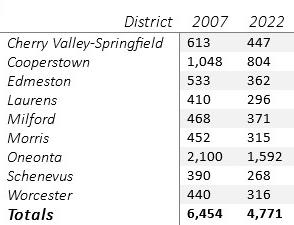The Partial Observer by Alex Thomas
There’s More to County Population Decline Than Meets the Eye…
School has recently begun and, if you are of a certain age, you may be wondering where all the students went. Back in the day, I graduated from CCS with a class of 107; last year it was, well, a lot less. The long-term trend is similar across the county, with public school enrollment dropping by over 25 percent as shown in the table. What’s happening?

You have reached your limit of 3 free articles
To Continue Reading
Our hard-copy and online publications cover the news of Otsego County by putting the community back into the newspaper. We are funded entirely by advertising and subscriptions. With your support, we continue to offer local, independent reporting that is not influenced by commercial or political ties.

